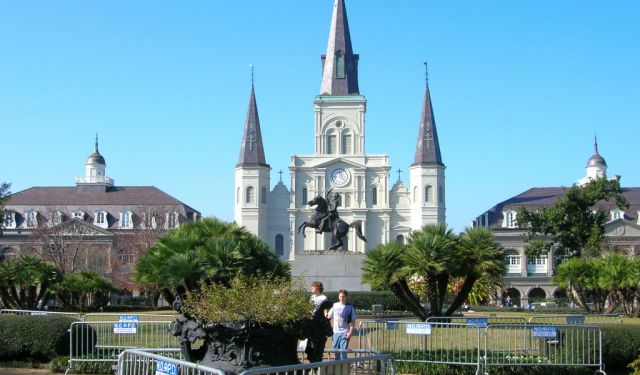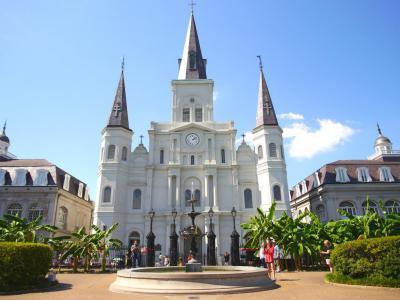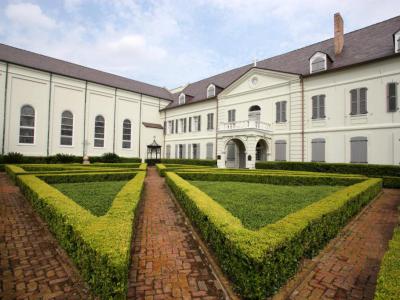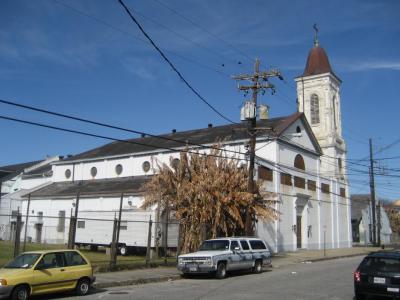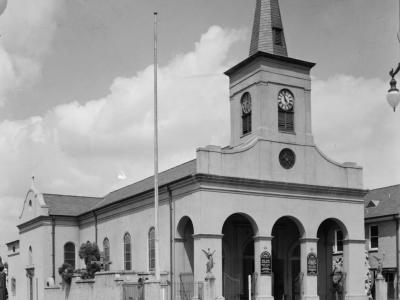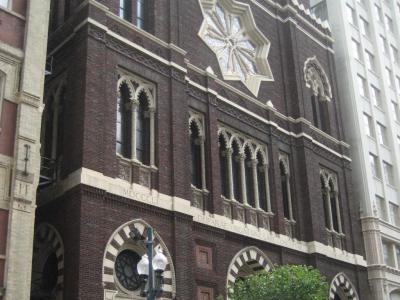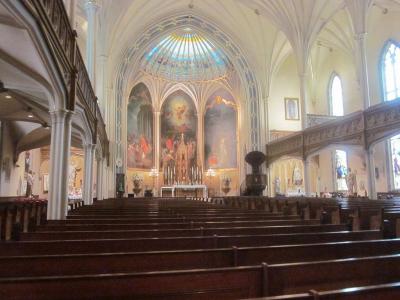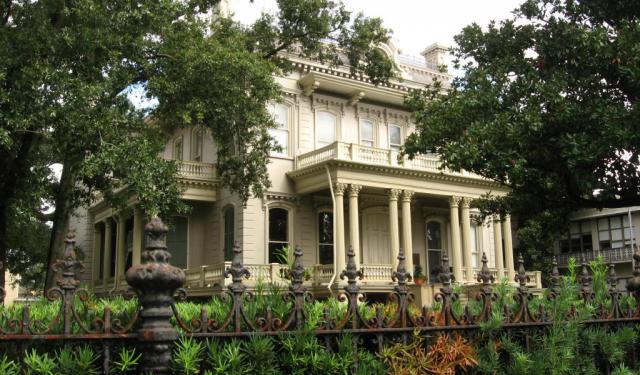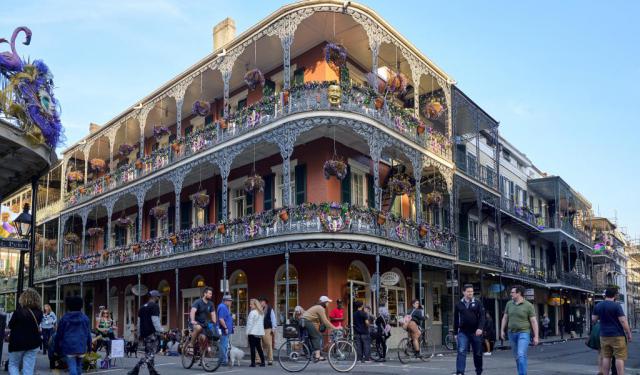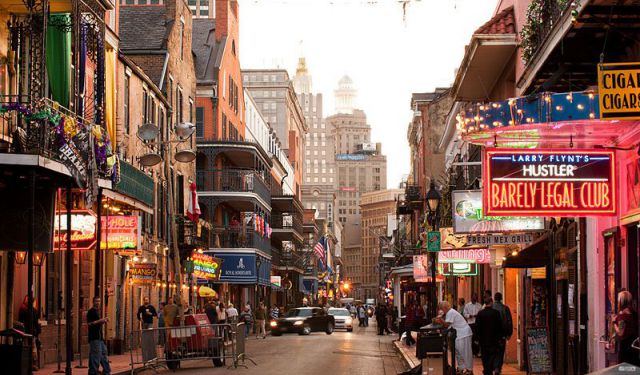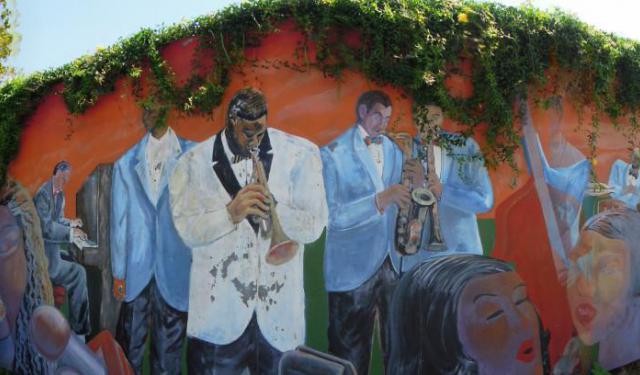Top Religious Sites Walking Tour (Self Guided), New Orleans
New Orleans has some of the oldest and most beautiful churches in Louisiana. Some of them, like the St. Louis Cathedral, have become iconic symbols of the city, while others are considered to provide "fresh air" to the busy business quarters.
The churches on this walking tour combine different architectural styles, starting with the Spanish Colonial & French Neo-Gothic design of the famed Cathedral overlooking Jackson Square. Interestingly enough, its adjacent cemetery is known as the burial place of Voodoo priestess Marie Laveau, whose tomb attracts hundreds of pilgrims every year.
The evidence of 17th/18th-century New Orleans is still evident here, as seen in the Neoclassical-style Old Ursuline Convent, which actually goes way back to the early 1700s and looks like something torn out of Louis XIV's Paris. Another great old church, Our Lady of Guadalupe is classic mission-style Spanish with wonderful windows and a nice mosaic of the Virgin up front, not to be missed.
The Immaculate Conception Church – a Jesuit parish – may seem overlooked compared to the area of the city it shares its space with, but the red brick exterior helps it to stand out with the towering buildings in the vicinity. Peaceful and very traditional, a visit here is also highly recommended.
Neglecting such treasures is like leaving New Orleans without having beignets, so take our self-guided tour to catch a glimpse of some exquisite places of worship.
The churches on this walking tour combine different architectural styles, starting with the Spanish Colonial & French Neo-Gothic design of the famed Cathedral overlooking Jackson Square. Interestingly enough, its adjacent cemetery is known as the burial place of Voodoo priestess Marie Laveau, whose tomb attracts hundreds of pilgrims every year.
The evidence of 17th/18th-century New Orleans is still evident here, as seen in the Neoclassical-style Old Ursuline Convent, which actually goes way back to the early 1700s and looks like something torn out of Louis XIV's Paris. Another great old church, Our Lady of Guadalupe is classic mission-style Spanish with wonderful windows and a nice mosaic of the Virgin up front, not to be missed.
The Immaculate Conception Church – a Jesuit parish – may seem overlooked compared to the area of the city it shares its space with, but the red brick exterior helps it to stand out with the towering buildings in the vicinity. Peaceful and very traditional, a visit here is also highly recommended.
Neglecting such treasures is like leaving New Orleans without having beignets, so take our self-guided tour to catch a glimpse of some exquisite places of worship.
How it works: Download the app "GPSmyCity: Walks in 1K+ Cities" from Apple App Store or Google Play Store to your mobile phone or tablet. The app turns your mobile device into a personal tour guide and its built-in GPS navigation functions guide you from one tour stop to next. The app works offline, so no data plan is needed when traveling abroad.
Top Religious Sites Walking Tour Map
Guide Name: Top Religious Sites Walking Tour
Guide Location: USA » New Orleans (See other walking tours in New Orleans)
Guide Type: Self-guided Walking Tour (Sightseeing)
# of Attractions: 6
Tour Duration: 2 Hour(s)
Travel Distance: 4.0 Km or 2.5 Miles
Author: DanaOffice
Sight(s) Featured in This Guide:
Guide Location: USA » New Orleans (See other walking tours in New Orleans)
Guide Type: Self-guided Walking Tour (Sightseeing)
# of Attractions: 6
Tour Duration: 2 Hour(s)
Travel Distance: 4.0 Km or 2.5 Miles
Author: DanaOffice
Sight(s) Featured in This Guide:
- St. Louis Cathedral
- Old Ursuline Convent
- St. Augustine Catholic Church
- Our Lady of Guadalupe Church
- Immaculate Conception Church
- St. Patrick's Church
1) St. Louis Cathedral (must see)
Saint Louis Cathedral's triple spires are instantly recognizable to most tourists as the main symbol of the French Quarter. Many have taken photos of the gleaming white facade set against a clear blue sky from across the picturesque Jackson Square; however, relatively few have ventured inside to witness the glorious mural and statuary, transporting visitors nearly 300 years back in time to the cathedral's founding. Along the first floor, stained glass windows depict the life of King Louis IX, the French monarch who led two crusades.
Saint Louis proudly holds the title of the oldest continuously active Roman Catholic Cathedral in the United States. The existing structure, which replaced two previous buildings destroyed by fires, dates back to 1794, though it underwent remodeling and expansion in 1851. The influences of both Spanish and French cultures are readily apparent in both the artwork and the flags displayed near the chandeliers in the main aisle of the sanctuary.
Notably, Pope John Paul II conducted a prayer service for clergy here during his visit to New Orleans in 1987; in commemoration of the event, the nearby pedestrian mall was renamed in his honor. Of particular interest is his portrait in a Jackson Square setting, displayed on the cathedral's inner sidewall.
Visitors can often enjoy free tours conducted by docents, or they can opt for a self-guided tour using brochures when there are no church events taking place. A fine pipe organ is frequently played for the delight of guests, and there is also a small gift shop to explore.
Tip:
Take note of the sloping floor, a clever architectural design that somehow manages to keep the building upright even as the ground beneath it continues to sink.
Saint Louis proudly holds the title of the oldest continuously active Roman Catholic Cathedral in the United States. The existing structure, which replaced two previous buildings destroyed by fires, dates back to 1794, though it underwent remodeling and expansion in 1851. The influences of both Spanish and French cultures are readily apparent in both the artwork and the flags displayed near the chandeliers in the main aisle of the sanctuary.
Notably, Pope John Paul II conducted a prayer service for clergy here during his visit to New Orleans in 1987; in commemoration of the event, the nearby pedestrian mall was renamed in his honor. Of particular interest is his portrait in a Jackson Square setting, displayed on the cathedral's inner sidewall.
Visitors can often enjoy free tours conducted by docents, or they can opt for a self-guided tour using brochures when there are no church events taking place. A fine pipe organ is frequently played for the delight of guests, and there is also a small gift shop to explore.
Tip:
Take note of the sloping floor, a clever architectural design that somehow manages to keep the building upright even as the ground beneath it continues to sink.
2) Old Ursuline Convent
King Louis XV of France founded the Old Ursuline Convent in 1745 to provide accommodation for the Ursuline nuns who arrived in New Orleans in the late 1720s, making them the first nuns to establish a lasting presence in what is now the United States. The convent, their second home, was completed in 1753 and is believed to be the oldest French-colonial building in the Mississippi River Valley, having survived the devastating 18th-century fires that consumed much of the French Quarter.
During its early years, the convent provided shelter to a diverse array of individuals, including French orphans, injured British soldiers, exiled Acadians, and the city's impoverished population. The entire complex on Chartres Street, which encompasses the gardens, Saint Mary's Church, and various related outbuildings, is named in honor of Antoine Blanc, the first archbishop of New Orleans.
The Old Ursuline Convent is now open to the public, featuring well-designed exhibits that provide insight into the city's history as well as the convent's own historical significance. Visitors also have the opportunity to view the former bishop's chapel within the adjacent church (not typically accessible to the public) with its exquisite stained glass windows, Stations of the Cross, and statuary. Another beautiful feature is the intricately hand-carved cypress staircase.
During its early years, the convent provided shelter to a diverse array of individuals, including French orphans, injured British soldiers, exiled Acadians, and the city's impoverished population. The entire complex on Chartres Street, which encompasses the gardens, Saint Mary's Church, and various related outbuildings, is named in honor of Antoine Blanc, the first archbishop of New Orleans.
The Old Ursuline Convent is now open to the public, featuring well-designed exhibits that provide insight into the city's history as well as the convent's own historical significance. Visitors also have the opportunity to view the former bishop's chapel within the adjacent church (not typically accessible to the public) with its exquisite stained glass windows, Stations of the Cross, and statuary. Another beautiful feature is the intricately hand-carved cypress staircase.
3) St. Augustine Catholic Church
Saint Augustine, the oldest African-American Catholic parish in the United States, stands on Saint Claude Avenue near the French Quarter, occupying the former Claude Tremé plantation site. Established in 1841, its history is closely intertwined with the community, including immigrants, slaves, and free people of color who played a pivotal role in its construction.
The church's architectural significance includes its design by J. N. B. de Pouilly, the same French architect renowned for his work on the nearby Saint Louis Cathedral. Notably, the pew arrangements reveal a fascinating history. In the past, pew fees were charged to parishioners seeking designated seating privileges, generating income for church operations. Free people of color purchased pews for their families and extended their generosity to less fortunate faithful, including slaves who couldn't afford seating. This led to the "War of the Pews", ultimately won by free people of color, resulting in the most integrated congregational church seating in the country.
Renowned for its inspirational music, Saint Augustine welcomes visitors of all faiths to its services, and also hosts the annual Jazz Mass as part of the Satchmo Summer Jazz Festival, paying tribute to Louis Armstrong. Exploring independently or joining a guided tour allows you to delve into its history, including the Tomb of the Unknown Slave, a poignant shrine honoring all enslaved individuals buried in Tremé.
Despite the threat of closure post-Hurricane Katrina, the determination of Saint Augustine Church's parishioners, along with grants and community support, ensured the preservation of this invaluable piece of living history.
The church's architectural significance includes its design by J. N. B. de Pouilly, the same French architect renowned for his work on the nearby Saint Louis Cathedral. Notably, the pew arrangements reveal a fascinating history. In the past, pew fees were charged to parishioners seeking designated seating privileges, generating income for church operations. Free people of color purchased pews for their families and extended their generosity to less fortunate faithful, including slaves who couldn't afford seating. This led to the "War of the Pews", ultimately won by free people of color, resulting in the most integrated congregational church seating in the country.
Renowned for its inspirational music, Saint Augustine welcomes visitors of all faiths to its services, and also hosts the annual Jazz Mass as part of the Satchmo Summer Jazz Festival, paying tribute to Louis Armstrong. Exploring independently or joining a guided tour allows you to delve into its history, including the Tomb of the Unknown Slave, a poignant shrine honoring all enslaved individuals buried in Tremé.
Despite the threat of closure post-Hurricane Katrina, the determination of Saint Augustine Church's parishioners, along with grants and community support, ensured the preservation of this invaluable piece of living history.
4) Our Lady of Guadalupe Church
If you happen to find yourself in New Orleans on a Saturday afternoon or Sunday morning and want to experience the city like a true local, attending at the oldest church in New Orleans is a must. In 1826, this church was constructed as a mortuary chapel for burying those who succumbed to yellow fever. At the time, there was a belief that the disease could spread from the bodies of the deceased, so funeral services at Saint Louis Cathedral were prohibited. Thus, the Mortuary Chapel was built on Rampart Street, near the cemeteries in use. Access to it was restricted, limited to priests, altar boys, and pallbearers carrying coffins. It lacked pews, and families would participate in the service by observing through the church's open doors.
By 1921, the chapel underwent restoration and became a place of worship for a Spanish-speaking Catholic congregation, now named Our Lady of Guadalupe. Over time, statues adorned the interior, and devotees came to pray to their favorite saints. In 1935, devotion to Saint Jude Thaddeus, the patron saint of impossible cases, began. A verified relic of Saint Jude was donated to the church, and a small statue of the saint was placed in a side niche. For the past half-century, Our Lady of Guadalupe has been recognized as a shrine dedicated to Saint Jude.
New Orleans has a saint for virtually every cause, and Saint Expedite, known for urgent matters and swift solutions, has gained popularity among computer tech enthusiasts, despite his unofficial status as a saint. Legend has it that the Chapel of Our Lady of Guadalupe ordered a statue of the Virgin Mary from France, but when the ship arrived, it carried two crates: the first contained the eagerly awaited Mary statue, while the second crate bore the word "EXPEDITE" and held a nearly 200-year-old statue of a Roman centurion. While the reason for sending this statue to New Orleans remains a mystery, local residents can often be seen rubbing its feet and beseeching it for miracles.
Tip:
The church is known for hosting "jazz" masses. If you have not been to a "jazz" mass before, it is well worth checking it out.
By 1921, the chapel underwent restoration and became a place of worship for a Spanish-speaking Catholic congregation, now named Our Lady of Guadalupe. Over time, statues adorned the interior, and devotees came to pray to their favorite saints. In 1935, devotion to Saint Jude Thaddeus, the patron saint of impossible cases, began. A verified relic of Saint Jude was donated to the church, and a small statue of the saint was placed in a side niche. For the past half-century, Our Lady of Guadalupe has been recognized as a shrine dedicated to Saint Jude.
New Orleans has a saint for virtually every cause, and Saint Expedite, known for urgent matters and swift solutions, has gained popularity among computer tech enthusiasts, despite his unofficial status as a saint. Legend has it that the Chapel of Our Lady of Guadalupe ordered a statue of the Virgin Mary from France, but when the ship arrived, it carried two crates: the first contained the eagerly awaited Mary statue, while the second crate bore the word "EXPEDITE" and held a nearly 200-year-old statue of a Roman centurion. While the reason for sending this statue to New Orleans remains a mystery, local residents can often be seen rubbing its feet and beseeching it for miracles.
Tip:
The church is known for hosting "jazz" masses. If you have not been to a "jazz" mass before, it is well worth checking it out.
5) Immaculate Conception Church
Known locally as the Jesuit church, this Roman Catholic marvel graces the Central Business District of New Orleans with its blend of Neo-Venetian Gothic and Gothic Revival styles, with hints of Moorish Revival and Byzantine Revival elements.
Interestingly, two Immaculate Conception churches, nearly identical in design, have stood on this site at different times. The first incarnation, envisioned by Fr. John Cambiaso, was completed in 1857. Unfortunately, in the late 1920s, that church suffered structural damage during the construction of the Pere Marquette building, leading to a dramatic split in its floor. In response, the original church was disassembled in 1928, and new foundations were laid on the same spot in 1929. The new construction, which incorporated numerous fixtures from the previous one, was completed and consecrated in 1930.
Although somewhat concealed amidst the surrounding skyscrapers, the Immaculate Conception is well worth exploring. Inside, you'll find exquisite stained glass windows and a breathtaking interior. The statues, frescoes, and altars all contribute to the undeniable beauty and spiritual atmosphere.
Interestingly, two Immaculate Conception churches, nearly identical in design, have stood on this site at different times. The first incarnation, envisioned by Fr. John Cambiaso, was completed in 1857. Unfortunately, in the late 1920s, that church suffered structural damage during the construction of the Pere Marquette building, leading to a dramatic split in its floor. In response, the original church was disassembled in 1928, and new foundations were laid on the same spot in 1929. The new construction, which incorporated numerous fixtures from the previous one, was completed and consecrated in 1930.
Although somewhat concealed amidst the surrounding skyscrapers, the Immaculate Conception is well worth exploring. Inside, you'll find exquisite stained glass windows and a breathtaking interior. The statues, frescoes, and altars all contribute to the undeniable beauty and spiritual atmosphere.
6) St. Patrick's Church
Just a stone's throw away from Lafayette Square lies Saint Patrick's Church, a historic place of worship that holds a special spot in New Orleans' American Sector. Now, you might wonder, why is it called the American Sector? Well, because in the 19th century, those savvy Americans decided to build their homes and businesses here, setting themselves apart from the Creoles dwelling in the original French Quarter.
Bishop Antoine Blanc gave his blessings to this church in 1838, and the finishing touches were put in place by 1840. Saint Patrick's stands as one of the last remnants of an area that was once bustling with grand mansions and upscale stores. Back in 1833, when the parish was established, the locale was known as the Faubourg Saint Mary. The Americans, many of whom were of Irish descent, were in need of a place to worship that matched the grandeur of the French Quarter's Saint Louis Cathedral.
Fast forward to today, and you'll find Saint Patrick's holding the title of a National Historic Landmark. It's famous not only for its rich history but also for its opulent interior, boasting lofty vaulted ceilings, majestic paintings, and exquisite stained-glass windows. Despite a significant renovation from 1978 to 1990, it's one of those rare structures that hasn't seen much change since its inception. Besides, unlike many buildings in the city, it stood its ground and emerged unscathed from the clutches of Hurricane Katrina.
Bishop Antoine Blanc gave his blessings to this church in 1838, and the finishing touches were put in place by 1840. Saint Patrick's stands as one of the last remnants of an area that was once bustling with grand mansions and upscale stores. Back in 1833, when the parish was established, the locale was known as the Faubourg Saint Mary. The Americans, many of whom were of Irish descent, were in need of a place to worship that matched the grandeur of the French Quarter's Saint Louis Cathedral.
Fast forward to today, and you'll find Saint Patrick's holding the title of a National Historic Landmark. It's famous not only for its rich history but also for its opulent interior, boasting lofty vaulted ceilings, majestic paintings, and exquisite stained-glass windows. Despite a significant renovation from 1978 to 1990, it's one of those rare structures that hasn't seen much change since its inception. Besides, unlike many buildings in the city, it stood its ground and emerged unscathed from the clutches of Hurricane Katrina.
Walking Tours in New Orleans, Louisiana
Create Your Own Walk in New Orleans
Creating your own self-guided walk in New Orleans is easy and fun. Choose the city attractions that you want to see and a walk route map will be created just for you. You can even set your hotel as the start point of the walk.
Garden District Walking Tour
It may come as a surprise, but New Orleans’ Garden District is known for its architecture more than for its gardens. The city’s elite residential neighborhood since the 19th century, when wealthy newcomers built opulent structures, it is considered one of the best-preserved collections of historic mansions in the South, and certainly one of the most picturesque. You can see why this is the... view more
Tour Duration: 1 Hour(s)
Travel Distance: 1.9 Km or 1.2 Miles
Tour Duration: 1 Hour(s)
Travel Distance: 1.9 Km or 1.2 Miles
Voodoo Tour
Voodoo is an ancient ritualistic practice brought by enslaved West Africans onto the American soil upon their arrival in the 18th century. This form of religion was most prominent in New Orleans from the 1820s through the 1860s, when it was introduced by the “Voodoo Queens”. Of these, Marie Laveau became more prominent as she overthrew other queens to become the sole oracle.
Your best... view more
Tour Duration: 1 Hour(s)
Travel Distance: 2.6 Km or 1.6 Miles
Your best... view more
Tour Duration: 1 Hour(s)
Travel Distance: 2.6 Km or 1.6 Miles
French Quarter Historical Buildings Walking Tour
Widely known for its heritage sites with a variety of unique architectural styles, New Orleans has lots of beautiful buildings designed in the Greek Revival, American Colonial, or Victorian styles. Walking around the French Quarter, you'll enjoy these old historic buildings (some open to the public), their old ironwork gates and balcony railings, the antique brick- and stone-paved sidewalks... view more
Tour Duration: 2 Hour(s)
Travel Distance: 2.3 Km or 1.4 Miles
Tour Duration: 2 Hour(s)
Travel Distance: 2.3 Km or 1.4 Miles
French Quarter Walking Tour
The French Quarter, also known as the Old Square, is New Orleans' oldest and most popular neighborhood. Founded in 1718, it perfectly combines the tempting, noisy and nutty nightlife of Bourbon Street with important historical landmarks, art galleries, sophisticated cafés, and some of the city's oldest churches – all within walking distance, close to Mississippi River.
On this... view more
Tour Duration: 2 Hour(s)
Travel Distance: 3.4 Km or 2.1 Miles
On this... view more
Tour Duration: 2 Hour(s)
Travel Distance: 3.4 Km or 2.1 Miles
African American Heritage Walking Tour
For over 300 years, the African-American community has played an intrinsic role in creating authentic New Orleans that everyone loves today. The bedrock of the city's life is built on the African-American experience, a heritage both proud and tragic, yet strong enough to have preserved throughout centuries the many aspects of African culture, influencing everything from religion to vibrant... view more
Tour Duration: 2 Hour(s)
Travel Distance: 3.6 Km or 2.2 Miles
Tour Duration: 2 Hour(s)
Travel Distance: 3.6 Km or 2.2 Miles
The Most Popular Cities
/ view all
